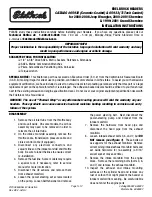
WARNING!
• Never place a rear-facing child restraint in front of an air bag. A deploying passenger
front air bag can cause death or serious injury to a child 12 years or younger,
including a child in a rear-facing child restraint.
• Only use a rear-facing child restraint in a vehicle with a rear seat.
How To Engage The Automatic Locking Mode
1. Buckle the combination lap and shoulder belt.
2. Grasp the shoulder portion and pull downward until the entire seat belt is extracted.
3. Allow the seat belt to retract. As the seat belt retracts, you will hear a clicking sound.
This indicates the seat belt is now in the Automatic Locking Mode.
How To Disengage The Automatic Locking Mode
Unbuckle the combination lap/shoulder belt and allow it to retract completely to
disengage the Automatic Locking Mode and activate the vehicle sensitive (emergency)
locking mode.
WARNING!
• The seat belt assembly must be replaced if the switchable Automatic Locking
Retractor (ALR) feature or any other seat belt function is not working properly when
checked according to the procedures in the Service Manual.
• Failure to replace the seat belt assembly could increase the risk of injury in collisions.
• Do not use the Automatic Locking Mode to restrain occupants who are wearing the
seat belt or children who are using booster seats. The locked mode is only used to
install rear-facing or forward-facing child restraints that have a harness for restraining
the child.
Supplemental Active Head Restraints (AHR)
These head restraints are passive deployable components, and vehicles with this equip-
ment cannot be readily identified by any markings, only through visual inspection of the
head restraint. The head restraint will be split in two halves, with the front half being soft
foam and trim, the back half being decorative plastic.
How The Active Head Restraints (AHR) Work
The Occupant Restraint Controller (ORC) determines whether the severity or type of rear
impact will require the Active Head Restraints (AHR) to deploy. If a rear impact requires
deployment, both the driver and front passenger seat AHRs will be deployed.
When AHRs deploy during a rear impact, the front half of the head restraint extends
forward to minimize the gap between the back of the occupant’s head and the AHR. This
system is designed to help prevent or reduce the extent of injuries to the driver and front
passenger in certain types of rear impacts.
G E T T I N G S T A R T E D
27
Summary of Contents for DURANGO 2017
Page 281: ...NOTES 279...
Page 282: ...NOTES 280...
















































